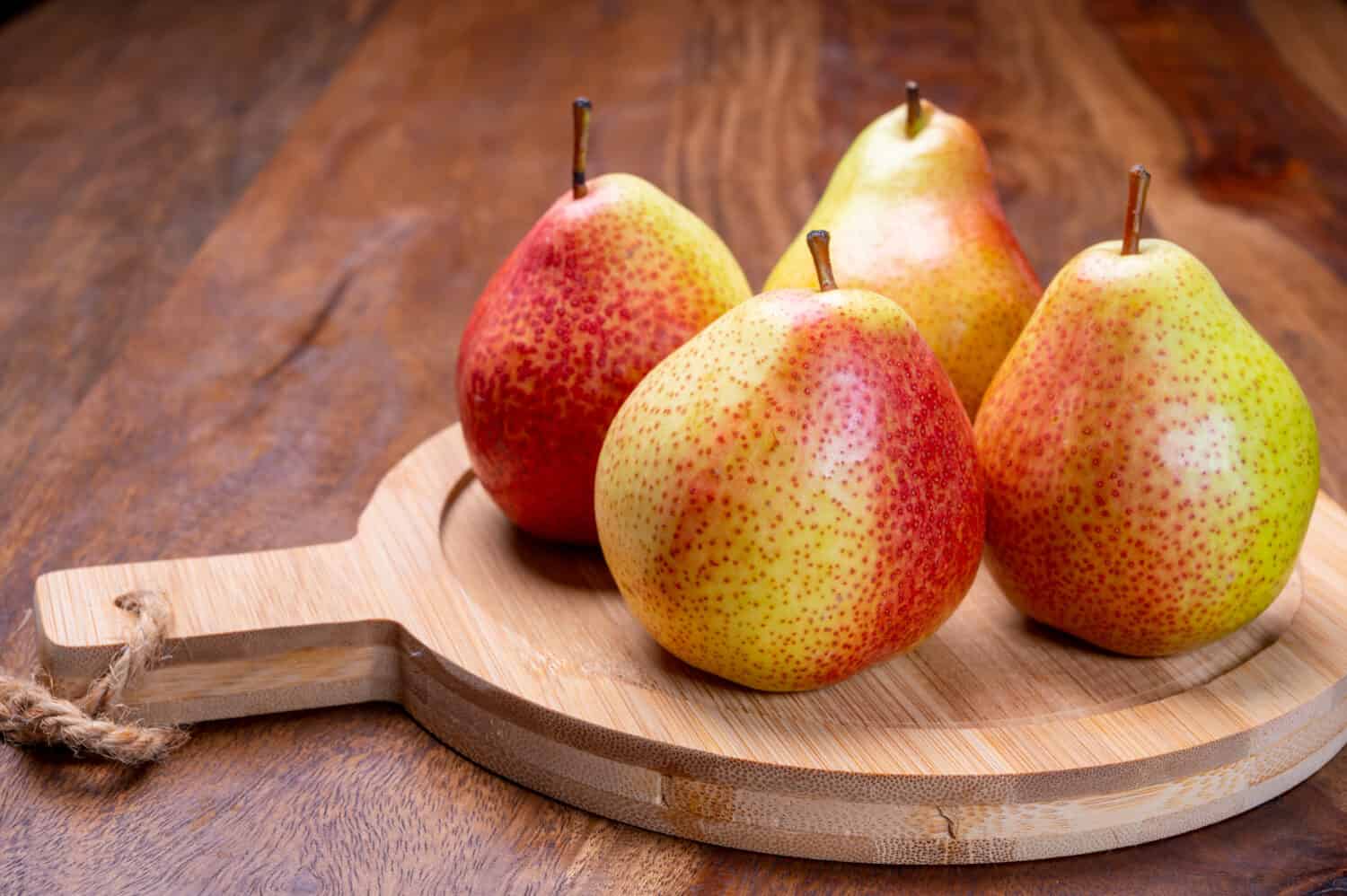Pears have it all — they’re delicious, nutritious, and versatile. Most people don’t realize that there are several types of pears, each with a unique flavor profile and texture. In this article, we’ll cover eleven different types of pears, their tastes, and their best culinary applications.
Let’s dig in!
1. Bartlett Pear
Botanical Name: Pyrus communis ‘Williams’
Known as the Williams pear in the UK, the Bartlett pear is among the most popular varieties in the Western hemisphere. It boasts the iconic pear shape with a large, rounded bottom, narrow top, and smooth skin that evolves from a deep green to a yellow tone as it ripens.
Bartlett pears are juicy, sweet, and aromatic. They become sweeter and softer as the ripening progresses. With a crisp mouthfeel, the Bartlett pear is excellent for eating as a snack or putting on salads. This versatile pear is also ideal for canning and desserts, like tarts or pies.
Bartlett pear trees will grow in USDA zones 5-8 in full sun and well-draining soil. This type of pear tree takes 4-6 years to bear fruit. Bartlett pear trees are partially self-pollinating but produce more fruit when cross-pollinated.
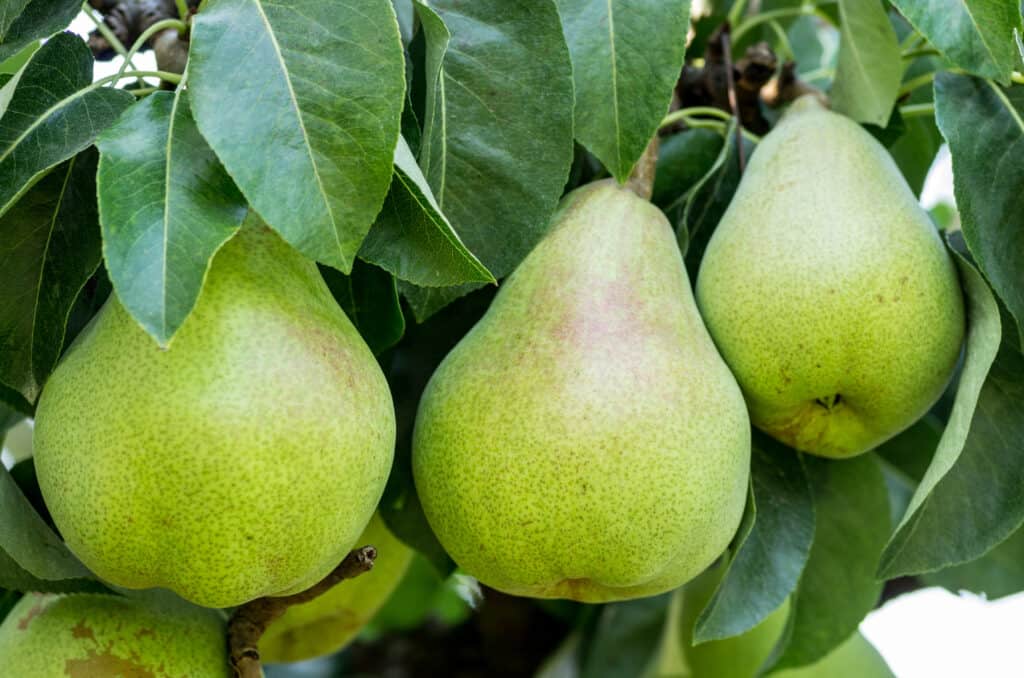
Bartlett pears are one of the most popular varieties in North America.
©Zigzag Mountain Art/Shutterstock.com
2. Anjou Pear
Botanical Name: Pyrus communis ‘D’Anjou’
Anjou pears are another common variety in North America. Sometimes called “Beurré d’Anjou” for its buttery color, Anjou pears also boast the iconic pear shape. However, the transition from the large bottom to the narrow top is much more subtle than that of the Bartlett.
Anjou pears have a sweet, mild flavor with a touch of tang. The flesh is smooth and firm, with a dense texture that holds up well when heated. Bake or poach these delicious fruits, or enjoy raw as a snack.
Anjous are green during the entire ripening process, making it impossible to tell their readiness by sight alone. According to USA Pears, the best way to test for readiness is to Check the Neck for Ripeness™ by applying pressure to the top of the pear. If it has a little give, it’s ready to enjoy.
Anjou pears grow well in USDA zones 5-8 and take 4-6 years to bear fruit. They require full sun, well-draining soil, and a partner tree for cross-pollination.
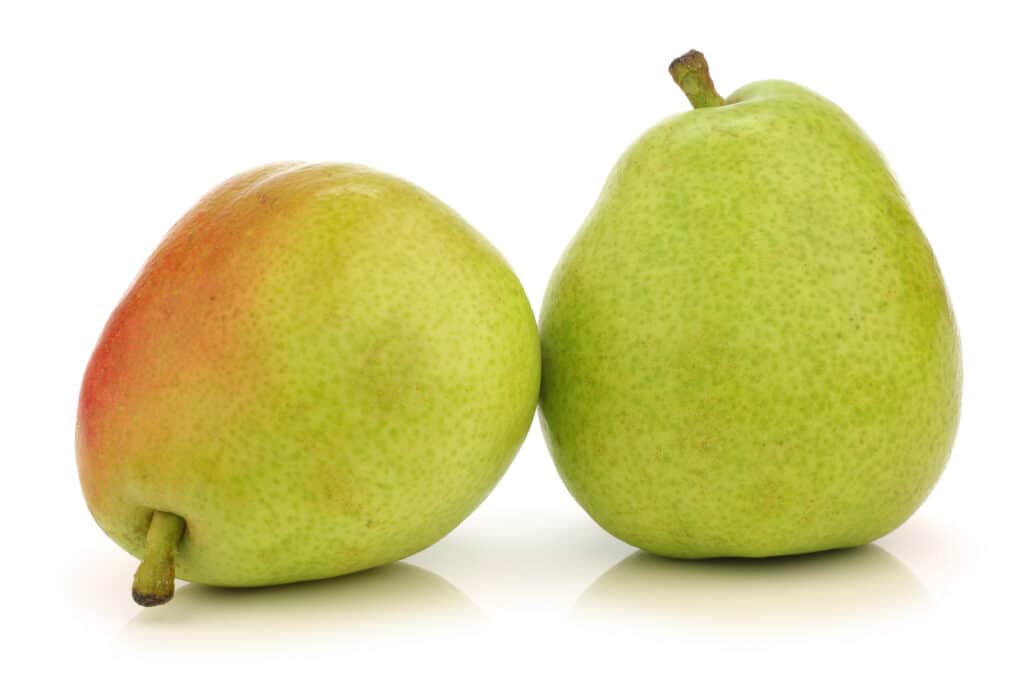
Anjou pears have a delicious, subtle flavor.
©Peter Zijlstra/Shutterstock.com
3. Bosc Pear
Botanical Name: Pyrus communis ‘Bosc’
Also known as the Kaiser pear, the Bosc is another cultivar of the European pear — closely related to the Bartlett and Anjou. The Bosc pear’s skin is a beautiful golden-brown hue, known for its russeted appearance. Boscs are winter pears and require cold storage after picking to achieve peak ripeness.
The Bosc pear has a crisp, sweet taste with a delicate touch of spice. It’s more textured than other pear varieties, giving it a unique mouthfeel. Its subtle spice makes it ideal for baked goods, and its density will withstand heat when poached. Of the many different types of pears, Bosc pears are the best for cheese platters and charcuterie boards.
Bosc pear trees grow in USDA zones 5-9 and perform well when planted late in the season for a fall-to-winter harvest. Provide full sun exposure, well-draining soil, and a partner tree for pollination for best results. With proper care, a Bosc pear tree will produce fruit in 4-7 years.

Bosc pears are more golden than Bartlett and Anjou pears.
©bergamont/iStock via Getty Images
4. Comice Pear
Botanical Name: Pyrus communis ‘Doyenné du Comice’
This delicious French pear doesn’t have the same Western notoriety as the Bartlett or Anjou, but it’s worth a taste. Known for being exceptionally sweet, juicy, and tender with a buttery texture, the Comice pear is quite round and has greenish-yellow skin with a red blush.
The Comice pear is incredibly tender and doesn’t hold up well when baked or poached. Some find its extreme sweetness to be cloying and overpowering. Use sparingly in salads or baked goods, or get creative with spiced cocktails. This sweet pear also presents well on a cheese platter or charcuterie board.
Comice pear trees grow in USDA zones 5-9 in full sunlight and well-draining soil. It takes 3-5 years for this self-pollinating tree to bear fruit.

Comice pears are sweet and don’t hold up well when heated.
©slowmotiongli/iStock via Getty Images
5. Seckel Pear
Botanical Name: Pyrus communis ‘Seckel’
Seckel pears, also known as sugar pears, are tiny and adorable. These miniature, round pears are vibrant green with a deep red blush. They’re known for being super sweet with just a hint of spice.
Seckel pears have a great crunch, making them perfect for handheld snacks and nutritious addition to lunch boxes. Their density also makes Seckel pears ideal for canning and preserving.
Seckel pear trees grow in USDA zones 5-8 in full sunlight and well-draining soil. Like the Bartlett, this pear variety can self-pollinate but produces more fruit when cross-pollination occurs. With ideal conditions, a seckel pear tree will produce fruit in 4-6 years.

Seckel pears are perfect for spicing and preserving.
©jatrax/iStock via Getty Images
6. Conference Pear
Botanical Name: Pyrus communis ‘Conference’
The Conference pear is one of the most popular pear varieties in Europe, thanks to its hardiness and flavor consistency. This unique-looking pear is long and narrow, like a Bartlett pear that’s been stretched out. It has a vibrant green tone with russeting that deepens during the ripening process.
Conference pears have a sweet, tangy taste and smooth, firm texture. They’re great when eaten as a standalone snack, added to salads, baked, poached, or preserved — it’s no wonder this pear is a fan favorite!
Conference pear trees will grow in USDA zones 4-8, though some avid gardeners have had success in zones 9-10. Provide full sun exposure and well-draining soil for this delicious pear. Conference pears can self-pollinate but produce a higher yield when cross-pollinated. It typically takes 4-6 years for this tree to bear fruit.
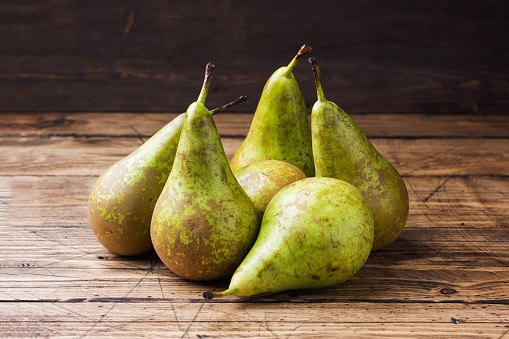
Conference pears are long and narrow with russeting.
©derketta/iStock via Getty Images
7. Forelle Pear
Botanical Name: Pyrus Communis ‘Forelle’
Forelle pears are a rare delight in North America. These oft-overlooked pears are slightly larger than Seckel pears with an exceptional burst of flavor and mouthfeel. The iconic pear shape with a short neck stands apart from other varieties with its red “freckling” that pops from the greenish-yellow skin. Forelle is Germanic for trout—an homage to its speckled appearance.
Forelle pears are sweet, refreshing, and vibrant, with a slight tanginess. They pair incredibly with fresh seafood as a fruit salsa or when poached and served with desserts. These unique-looking fruits are also commonly used in decorations, such as centerpieces or floral arrangements.
Forelle pear trees grow in USDA zones 5-9 in full sunlight and well-draining soil. Forelles are not self-pollinating and require a pollination partner to produce fruit. Forelles are known for being high-maintenance and tricky and may not produce fruit for many years.
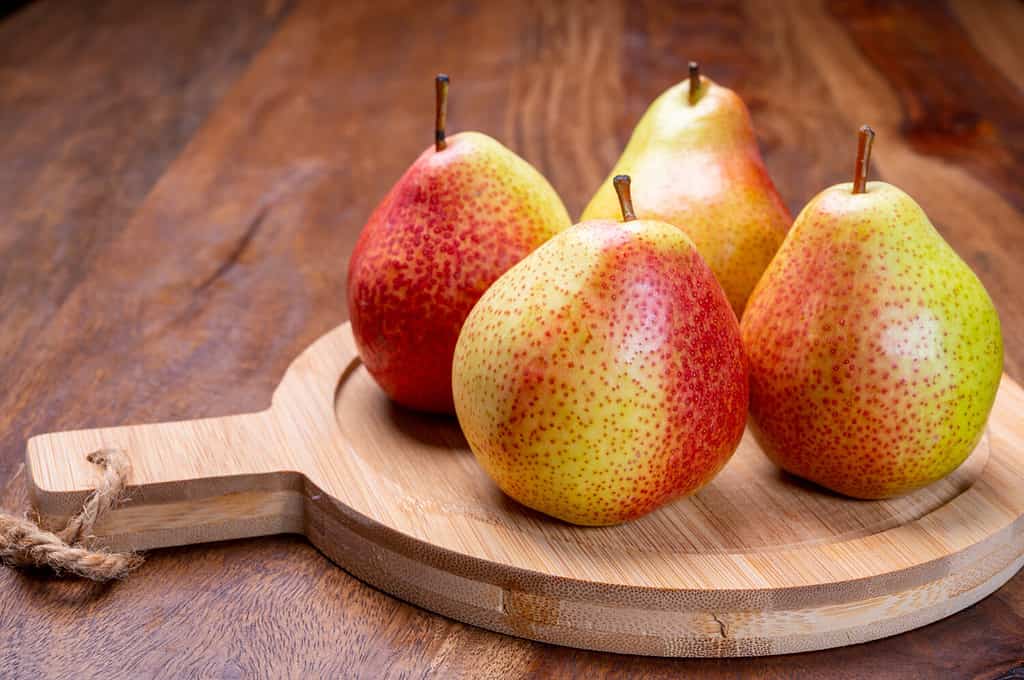
Forelle pears are recognizable by their iconic red freckles.
©barmalini/Shutterstock.com
8. Starkrimson Pear
Botanical Name: Pyrus Communis ‘Starkrimson’
The Starkrimson pear is truly unique, with a vibrant red color that stands apart. Its name is a portmanteau of “Stark,” after the botanical brothers who cultivated this pear, and “crimson” for the stunning red color.
Starkrimson pears have a mild floral taste with a subtle sweetness that translates well to many dishes. Its dense flesh and vibrant coloration make it an ideal cocktail garnish or addition to cheese platters and charcuterie boards. This beautiful fruit also looks stunning when poached and added to a dessert dish.
Starkrimson pear trees will grow in USDA zones 5-8 with full sunlight and well-draining soil. While the Starkrimson is self-pollinating, it produces more fruit when cross-pollinated. With ideal conditions, it will produce fruit in 4-6 years.
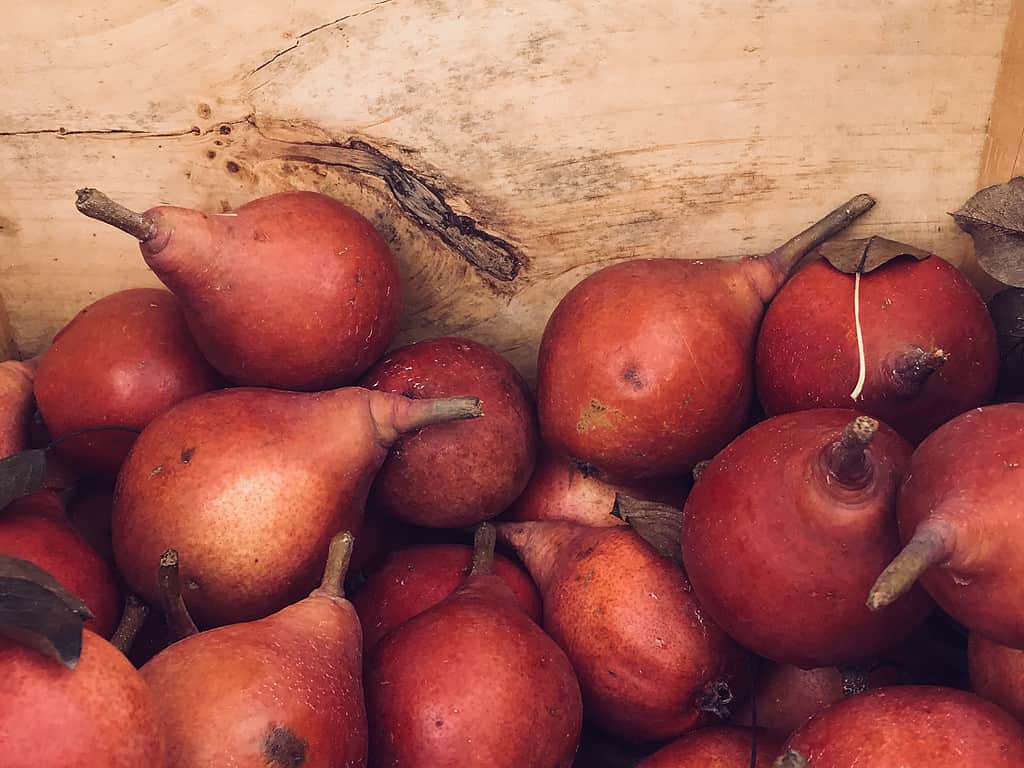
Starkrimson pears are a stunning shade of red.
©automatix/iStock via Getty Images
9. Winter Nelis Pear
Botanical Name: Pyrus communis ‘Winter Nelis’
Winter Nelis is an heirloom pear that closely resembles natural pears of the 1800s. They’re more rounded than “modern” pears and have rougher skin that stands out against the more polished cultivars. The rounded shape and muted, russeted skin don’t take away from the flavor, though; this delicious pear has a rich flavor with a hint of earthy spice.
Winter Nelis pears add a depth of flavor to desserts and chutneys. They hold up well in cooking and baking but are best enjoyed when eaten fresh.
The Winter Nelis pear tree will grow in USDA zones 5-9 with full sunlight and well-drained soil. As an heirloom variety, it does well in clay-rich soil as well. The Winter Nelis tree needs a pollination partner to produce fruit, which will take 4-6 years.

Winter Nelis pears are an heirloom variety.
©Wirestock Creators/Shutterstock.com
10. Taylor’s Gold Pear
Botanical Name: Pyrus communis ‘Taylor’s Gold’
Taylor’s Gold is a unique variety of pear, as it is a naturally occurring mutation of the Comice pear. While botanists or food scientists effectively create hybrids and cultivars, mutations evolve entirely on their own. Like the Comice pear, it’s sweet and juicy with smooth, buttery flesh. The Taylor’s Gold pear has golden skin and more closely resembles a Bosc pear, though the flavor is more like the Comice.
Taylor’s Gold is also more durable than the Comice pear, making it ideal for cooking and baking. Like its parent pear, this delicious treat also works well on cheese platters and charcuterie boards.
Taylor’s Gold pear trees aren’t well-established in North America. As this variety is a mutation, getting it to grow properly requires a lot of care and attention. Try growing this tree in USDA zones 5-9 with full sunlight and well-draining soil. Provide partner trees for cross-pollination. Even with proper care, your tree may never produce fruit.
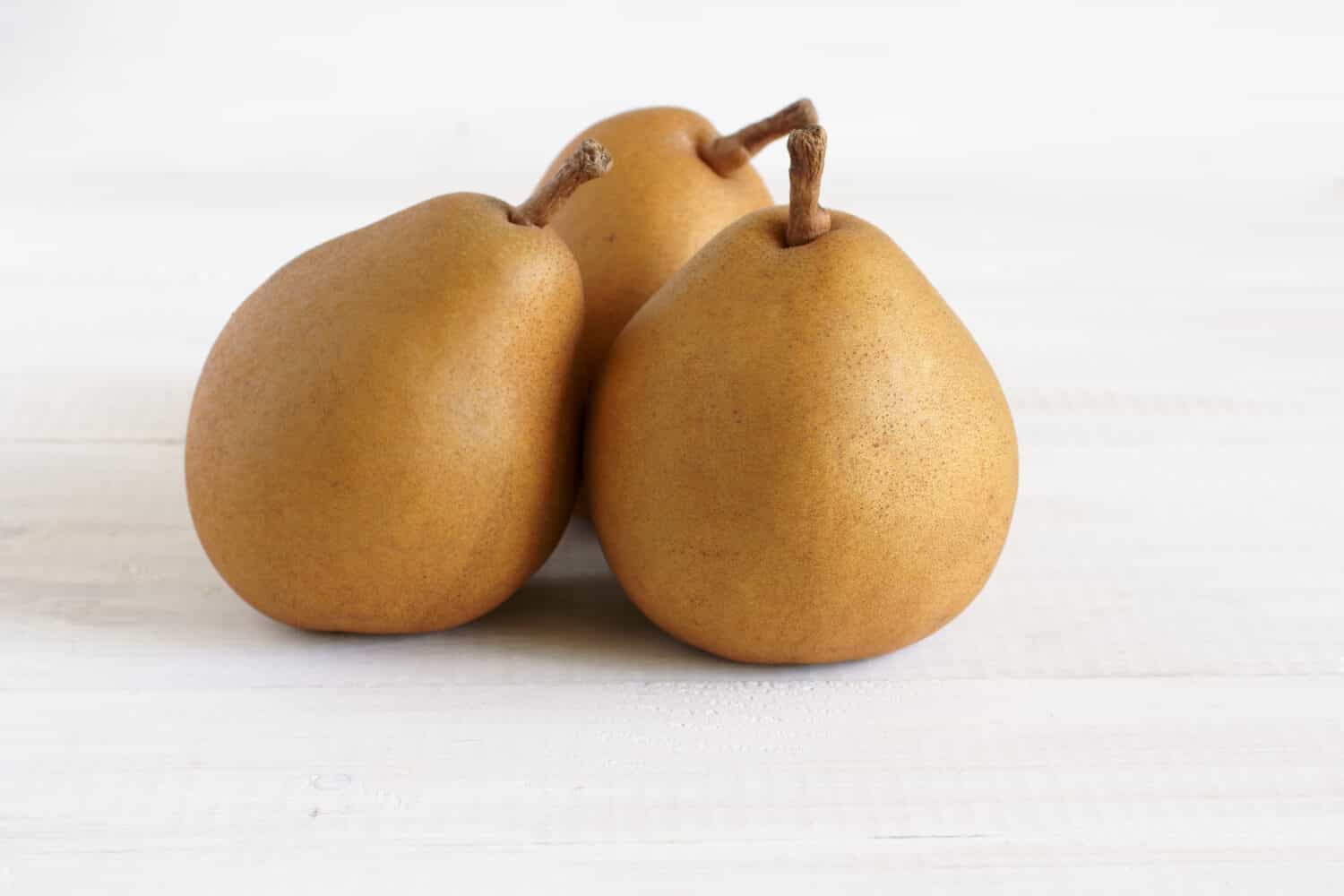
Taylor’s Gold Pears are a mutant.
©David Pimborough/Shutterstock.com
11. Concorde Pear
Botanical Name: Pyrus communis ‘Concorde’
The Concorde pear is a hybrid between the Comice and Conference varieties. This delicious pear has the sweetness and buttery texture of the Comice but the density and length of the Conference, making it better for baking and cooking than the Comice, but just as tasty. The combination also produces a unique vanilla flavor that culinary enthusiasts love.
Concorde pears are incredible when paired with cheese or made into chutneys for charcuterie platters. This dense pear also holds up well when poached or baked into desserts.
The Concorde pear tree does best in USDA zones 5-9. This self-fertile plant requires full sunlight and well-draining soil to thrive. Concorde pears can start producing fruit as early as two years into maturation, but 3-4 years is more likely.
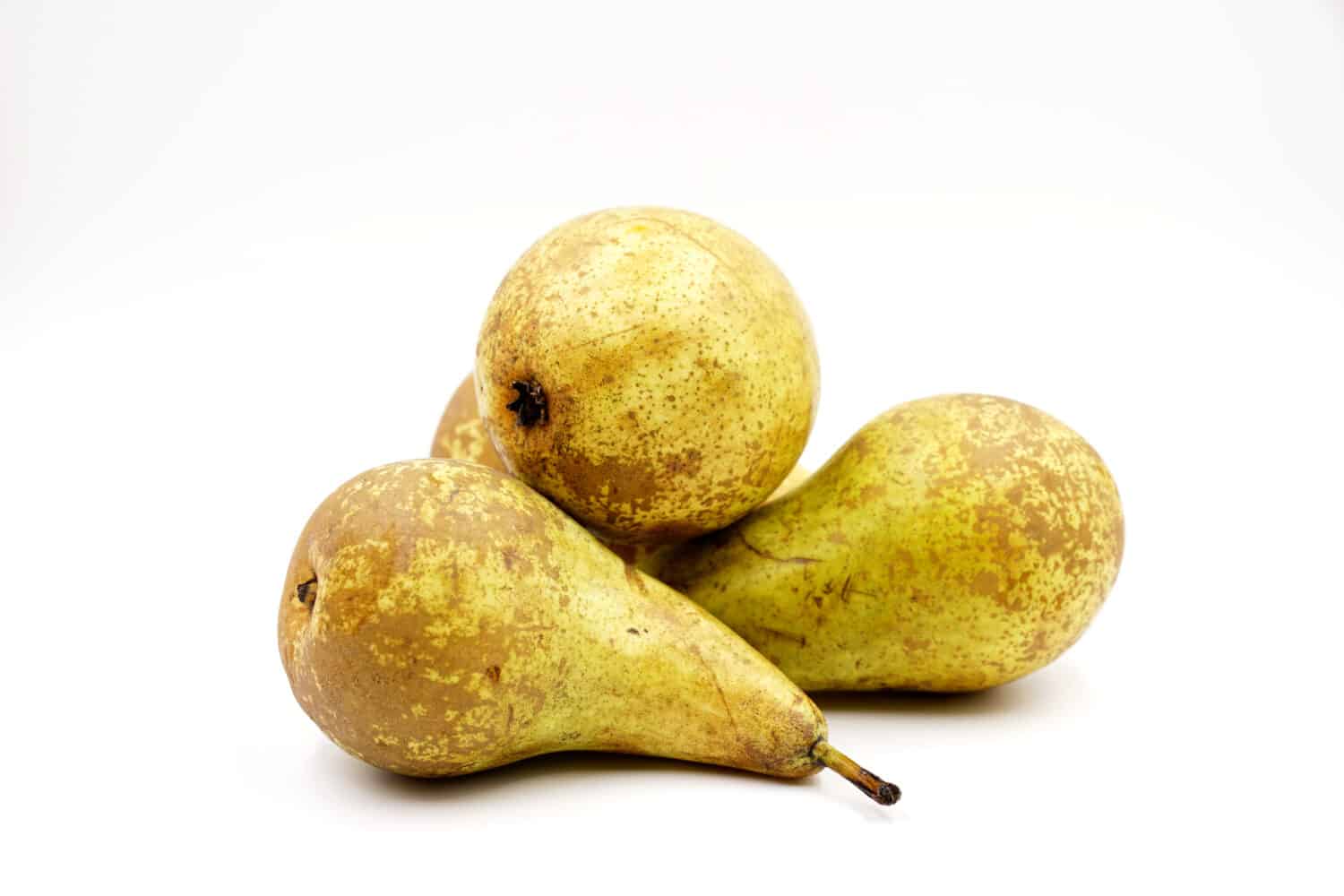
A hybrid of the Comice and Conference, the Concorde offers the best of both types.
©Yoyochow23/Shutterstock.com
Thank you for reading! Have some feedback for us? Contact the AZ Animals editorial team.

